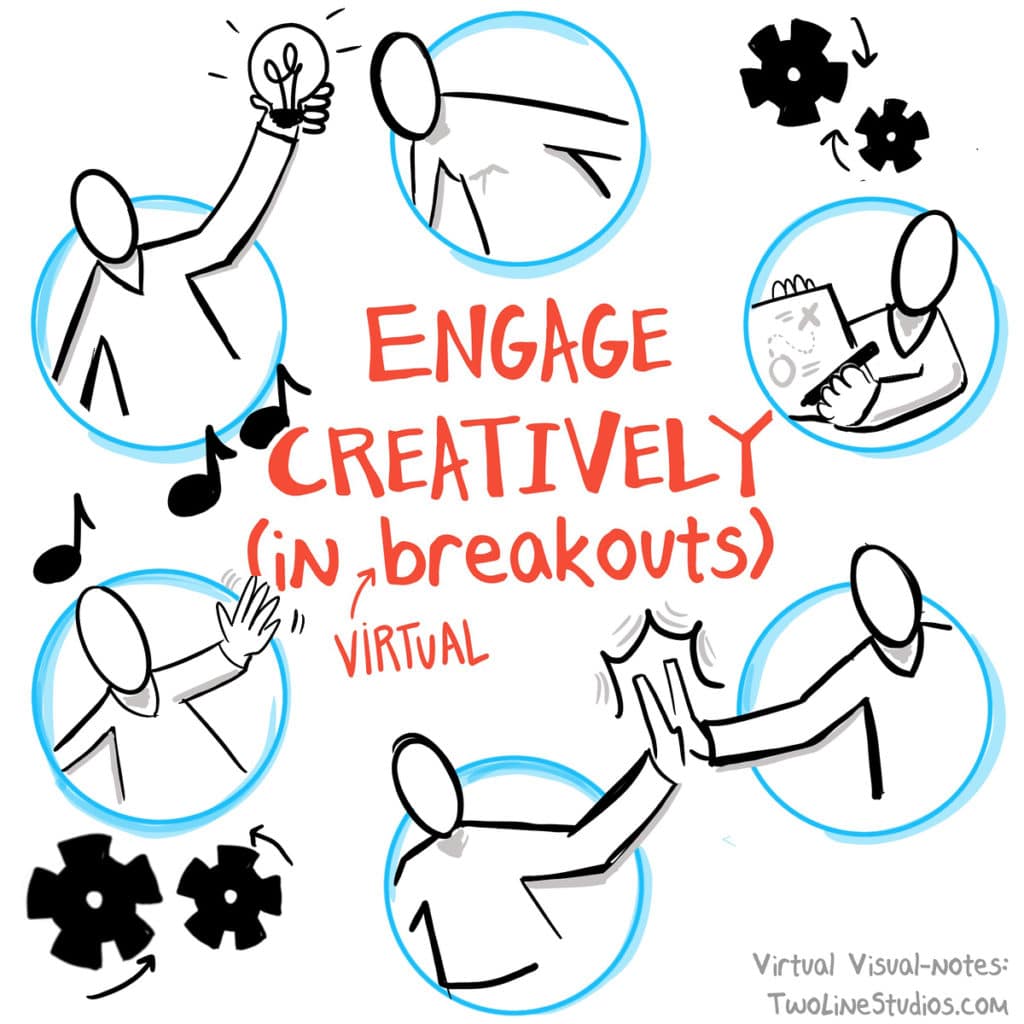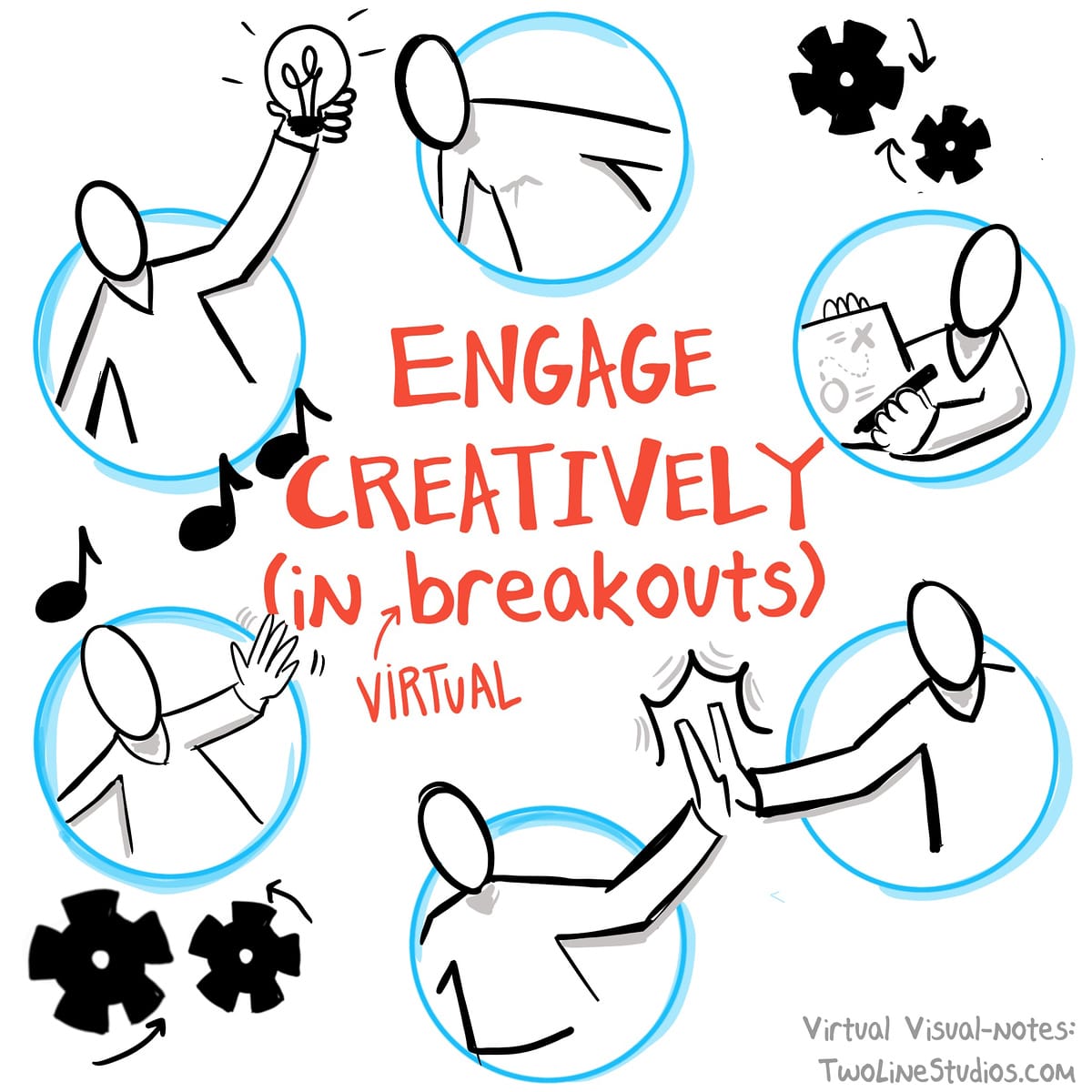
Can an online learning event be as engaging as a live one, or even more engaging? Online learning is notorious for distracted multitaskers and high drop out rates.
The secret, according to experts, is breakout groups. I’d point you to
How do you provide consistently high-quality breakout sessions? What’s the best way to structure them to stay on point? How do you ensure they’re facilitated well without professional facilitators in each room? How do you keep tabs on progress when you can’t walk around a room and visit tables?
There are challenges, but virtual breakouts offer at least four big opportunities:
Deeper Learning. Doesn’t learning happen best in small groups? The practice of learning in “Circles, Not Rows” has been our inspiration for years. In circles, people open up, reveal their real challenges and let in new ideas. Most adults learn better when having a dialogue about a current need. When sharing experiences, they learn better and the effects last longer. This is why Circle-style learning is so beloved by members of
Valuable Relationships. One of the worst aspects of moving online is that you lose the hallway, elevator, lunch or bar conversations where relationships are built. But with proper structure, the participants of a small group can connect even more quickly and meaningfully than when they make table-talk. This leads to meaningful relationships. If you keep the groups together, they form lasting bonds, sharing networks and helping each other outside the training world. As our friend Andy Billings from Electronic Arts quipped, “We spend time choosing the best presents (content) but participants just want to play with the boxes (relationships).”
Sustained Learning. What motivates participants to continue to practice learnings over time? Teams. People will show up for each other all day long before helping themselves. The Stanford research cited above shows it (16x more likely to complete a course than alone!), as does our experience. And all-of-a-sudden, the learning isn’t building-constrained. Go from a huge room of people meeting once, to small, intense groups meeting over time. Reinvest the saved travel time. Take advantage of peer accountability to drive sustained attention to a topic, and to support follow-through, which we know is required for behavior to change. If you do a good job framing the small group, and creating a dynamic of helping each other, they will stay together.
Teaming Skills. Take advantage of the team “dojo” to teach teaming skills in a safe place. Give participants turns at facilitating as part of the learning experience, and provide feedback to facilitators. Show how good meeting structure works. People can experience the power of psychological safety and vulnerability, and how to create it. Participants experience the effectiveness of team accountability, and how inclusion puts a plethora of diverse ideas on the table. Another one of our sayings: if you learn in teams, you’ll learn to lead teams that learn. Learning programs can play a crucial role in organizations struggling to improve collaboration by making team-based learning central to their approach.
The traditional “classroom” mode of presenting content to rows of individuals is a hard habit to break. Even our video conference tools are built more for presentations than conversations – one person is big by default with the others off screen, able to hide. And the closeness of Circles can produce uncomfortable conversations that some resist. Yet Learning & Development (L&D) professionals are no strangers to making people a little uncomfortable, for their own good, yes?
We believe that human connection is the magic ingredient in developing workers and leaders. Here’s how to put human connection front and center, and create an awesome event:
- Small groups
- Structured conversations
- Facilitation
- Intentional setting
Small Groups. Having people experience the entire learning journey in circles is the best way to translate live rooms to online rooms.
- Form Circles of 4-9 people before or at the start. Be deliberate about Circle creation. Turn the time saved by travel into a brief meeting to
- Restructure the session to go to breakouts 2-3 times while together. Have teams report out in between.
- Have the Circle continue. Setting up 2-5 short sessions after the workshop will keep attention on topic and focus on its real-life applications, multiplying your returns. Once the connection is built, the gravitational pull of helping each other will keep the Circle coming back to attend these sessions.
(We see over 80% attendance in our corporate Circle programs, even after 6 sessions). - Regroup. Why not gather again in 90 days, for an hour, and report out? What’s a learning journey without a final exam or performance? It’ll keep focus and give a real sense of closure.
Structured Conversations. It isn’t enough to let the small group just “talk.” Simple structures multiply the productivity of the group. We use the term “agenda” – but not as in a list of things to talk about, as in guidelines for how to run the conversation. For example:

- Advance-plan questions or prompts for discussion.
- Equal talk time. Use facilitation tricks like random order and a timer.
- Reflection. 60 seconds to think after a question feels weird at first, but shortens and deepens responses, allowing everyone to be present to hear each other.
- Meeting openings. Use a prompt to prime the topic and engage emotions, right away.
- Meeting close. Make sure to integrate the discussion into action items, or learnings that you can report out.
There are many other structures that you can use when creating your agenda. A Circle fosters inclusive conversations, psychological safety, and peer accountability. The trick is to take the cognitive load off the newly formed group by providing them one clear choice. Over time, these structures are internalized and the conversation gets more organic.

Facilitation. Wouldn’t it be powerful to have a facilitator in every breakout? Having a clear and thoughtful structure makes it possible for a motivated amateur to facilitate. One way to motivate them is to make facilitation part of the learning journey itself – this is a skill most professionals value.
I don’t want to undersell the value of experienced, skilled facilitation (as an exceptional example and shout-out, check out
“Offsite” Setting. L&D leaders go to great pains to locate live learning sessions in appropriate settings. It boosts learning when you take people out of their day-to-day mindset, fast. Isn’t it even more important to do that online? Think beyond the squares: use music, images, and strong openings to set a mood of openness and wonder, conducive to learning. Tech chaos can have the opposite effect.

And now the commercial – Circles is a gang of people with a process and platform for engaging, small group learning. We make it easy to design sessions, form small groups and measure how they do. We provide a purposeful setting, scalability, and professional service, powered by our technology. We can work with any major video conference provider for large sessions, and enhance the experience with Breakout Circles™️ that keep going.
